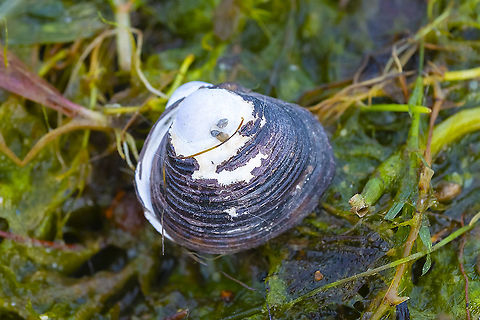
Appearance
''Corbicula'' have had global success as an aquatic invasive species, having been introduced to a novel range including South America, North America and Europe. Human industrial activity, such as transport of larvae via ballast water in container ships, has been noted in the literature as a chief invasion vector. A market exists for Asian clams for human consumption in Japan, China, and other countries in the region. According to the United States Geological Survey, ''C. fluminea'' is likely to continue to expand its North American range until it reaches the maximum extent of its low temperature tolerance. The periostracum of the shell is normally yellow-green, with concentric growth rings of the prismatic layer visible through the proteinous outer layer. The periostracum can flake, allowing the white prismatic layer to show through. The shells exhibit a light purple nacre on the inside.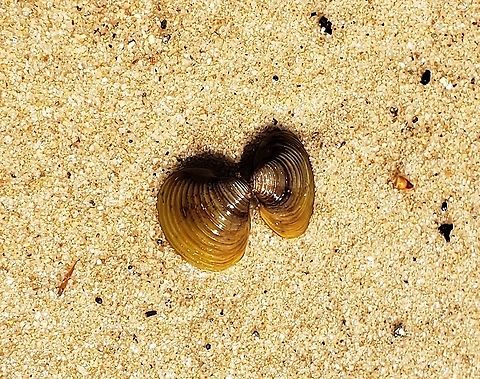
Naming
This clam originally occurs in freshwater environments of Eastern Asia, including Russia, Thailand, the Philippines, China, Taiwan, Korea, and Japan. ''C. fluminea'' also occurs naturally in freshwater environments of Africa.Many coastal rivers with a heavy industrial shipping presence in the invaded range of ''C. fluminea'' sustain Asian clam populations. Various non-indigenous populations of ''C. fluminea'' include:⤷ British Columbia circa 1924
⤷ The Columbia River in the northwest United States in 1938
⤷ Cuba
⤷ Lake Tahoe, on the borders of California and Nevada, they were first found in 2002, and the numbers increased rapidly after 2008.
⤷ Lake Placid, NY, USA
⤷ South America, including Argentina, Uruguay, Brasil , Perú, Venezuela and Ecuador .
⤷ Germany's Rhine River in the late 1980s
⤷ Danube River through the Rhine-Main-Danube Canal.
⤷ It reached the Elbe in 1998 at the latest.
⤷ River Nore & Barrow, Republic of Ireland, first recorded in April 2010
⤷
⤷ Czech Republic - in Elbe in Bohemia since 2000 and it is spreading.
⤷ Slovakia
⤷ Minho River in Portugal
⤷ Between August 15-28 2020 in Briggs Lake in Minnesota. However UMN Extension does not believe they are able to naturally survive in Minnesota, instead surviving only in the higher temperatures of power plant coolant water.
⤷ Shuswap Lake, British Columbia, Canada in 2020.
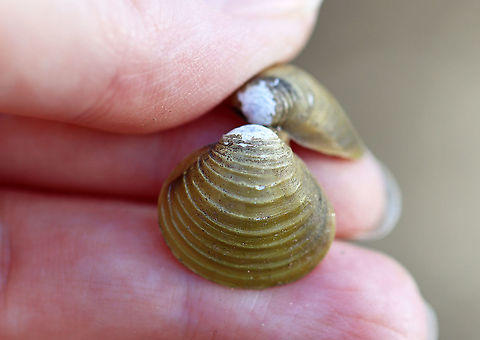
Behavior
Right after reaching maturity, these clams produce eggs, followed by sperm. Throughout adult life, ''Corbicula'' is a self-fertile simultaneous hermaphrodite which can broadcast spawn up to 570 mucoid larvae per day per individual, and more than 68,000 per year per individual. Larvae are ~200 microns in length when discharged from an adult and dispersed through water until becoming sessile adults. Adults can reach a length of about 5 cm.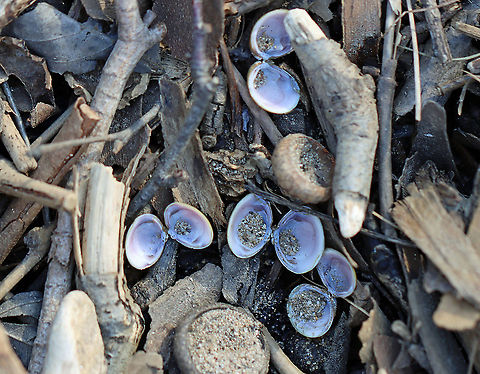
Habitat
Studies on which abiotic habitat characteristics are most strongly associated with Asian clam population abundance have produced varying results. Brazilian habitats have been found to have support the largest abundances of invasive ''Corbicula'' spp. in areas with coarser dominant sediment fractions, while negatively correlated with increasing levels of organic matter. Others studies have shown abiotic habitat characteristics such as water redox potential, inorganic nutrient content, hardness, and organic matter content in tandem with the amount of very course sand combine to explain 59.3% of ''Corbicula'' population habitat association via statistical tests. Asian clam invasions seem to be limited by elevation , latitude as well as the minimum winter temperature of the ecosystem.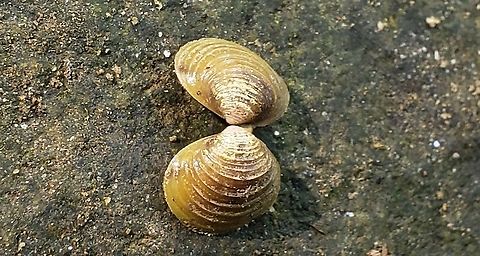
Food
''Corbicula fluminea'' is an active suspension feeder, and in the process of feeding by pumping water through its body . They feed primarily on phytoplankton , which they actively filter out the water, but may pedal feed on organic matter in the sandy or muddy bottoms of streams, lakes, or canals where the clam establishes a population.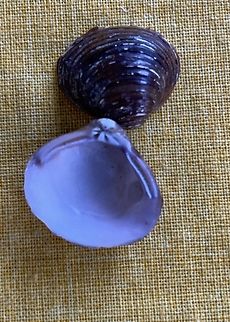
Evolution
''C. fluminea'' enjoys several physiological capabilities which are advantageous in promoting its invasion of novel lentic/lotic environments including:⤷ Rapid individual growth rate
⤷ Short time to reach sexual maturity
⤷ Short lifespan paired with high fecundity
⤷ Fast rate of water filtration for suspension feeding
⤷ Ability to broadcast gametes over a broad area by utilizing water flow
⤷ Tolerance of a wide variety of substrate/habitat types
C''orbicula fluminea'' is a self-fertilizing, simultaneous hermaphrodite which can asexually produce internally-brooded, semi-buoyant planktonic larvae when spermiogenesis is induced at temperatures above 10°C. This allows ''C. fluminea'' to colonize novel habitats at an advanced rate.
References:
Some text fragments are auto parsed from Wikipedia.